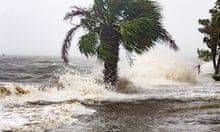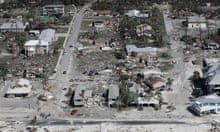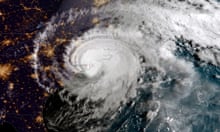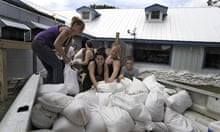As Hurricane Michael approaches the Florida Panhandle after rapidly intensifying to a category 4 storm, coastal areas have been evacuated. The storm is the second to hit the US mainland this year after Hurricane Florence brought catastrophic rainfall and flash floods to the Carolinas. 2018 has now exceeded what was expected to be a year of “below normal” hurricane activity, with long-term trends indicating a worsening of the length and intensity of Atlantic storms.
1970
Since 1970, there has been an average of six Atlantic hurricanes per year.
What is a hurricane?
A hurricane is a large rotating storm that forms over tropical or subtropical waters, though they’re only given such a name if formed in the Atlantic or eastern Pacific oceans. Similar storms in the Indian Ocean and South Pacific are known as cyclones, and those formed in the western Pacific are called typhoons.
Hurricanes fall into one of five tiers based on wind speed – known as categories – measured by the Saffir-Simpson scale. Hurricanes classed as category 3 or greater are called major hurricanes, while those that are category 1 and 2 are known as non-major hurricanes. Any storm with sustained winds of at least 39mph is assigned a name, which helps communicate warnings to the public.
Hurricanes can be deadly. Category 5 Hurricane Maria left 2,975 dead in Puerto Rico last year, though the unofficial toll may be as high as 4,600. In Dominica, Maria damaged or destroyed 95% of the island’s buildings.
Are they getting worse?
Two common measures used to judge whether hurricanes are becoming worse are the number of storms per year and the strength of each storm. Based on the total number of named storms, there has been an increase since the start of the 20th century.
Category 5 hurricanes are the most severe but also the most rare – there have been just three in the past decade.
But these hurricanes aren’t the only category of storm that cause significant damage. Hurricane Harvey showed us last year that a category 4 storm can last for several days and dump historic volumes of rain to almost sink an entire city.
To more accurately assess how bad a storm is, meteorologists use the Accumulated Cyclone Energy Index – or ACE – to account for the strength, frequency and duration of storms per year. The Atlantic Ocean is in the midst of its worst stretch on record.
The El Niño effect – which causes tropical storm development in the Atlantic to be suppressed – is a big reason why NOAA reduced the number of hurricanes forecast this year. However, new data suggests that hurricanes could become stronger, slower and wetter in the future.
Why is the number of named storms growing?
The increase in named storms can be attributed to human-induced climate change. As a result, the world’s oceans continue to warm at a fast rate, which means hurricanes are more likely.
Hurricanes draw their energy from deep below the ocean’s surface – up to depths of 2,000m. The temperature at these depths is measured by Ocean Heat Content, a metric that has soared since 1970, driven largely by four of the world’s major oceans. Last year was the hottest on record.
Warmer waters have made the speed at which hurricanes intensify in strength faster in recent years. Meteorologists use the term “rapid intensification” – or RI – to describe a storm that increases its maximum sustained winds by at least 35mph within a 24-hour period.
In 2017, there were 40 separate cases of RI – the most in at least 35 years. What’s particularly worrying is when a storm transforms from a category 1 hurricane to a Category 5 monster in less than 24 hours. In the case of Hurricane Maria, this left people on the island of Dominica with insufficient time to prepare.
Rapid intensification was part of the reason why Maria cost an estimated $90bn (£70bn). Damage caused is often used to evaluate how bad a hurricane is, but with more people and more infrastructure in vulnerable areas, cost is a flawed measure. Maria is joined by Harvey and Irma inside the five costliest hurricanes to hit the US on record.






